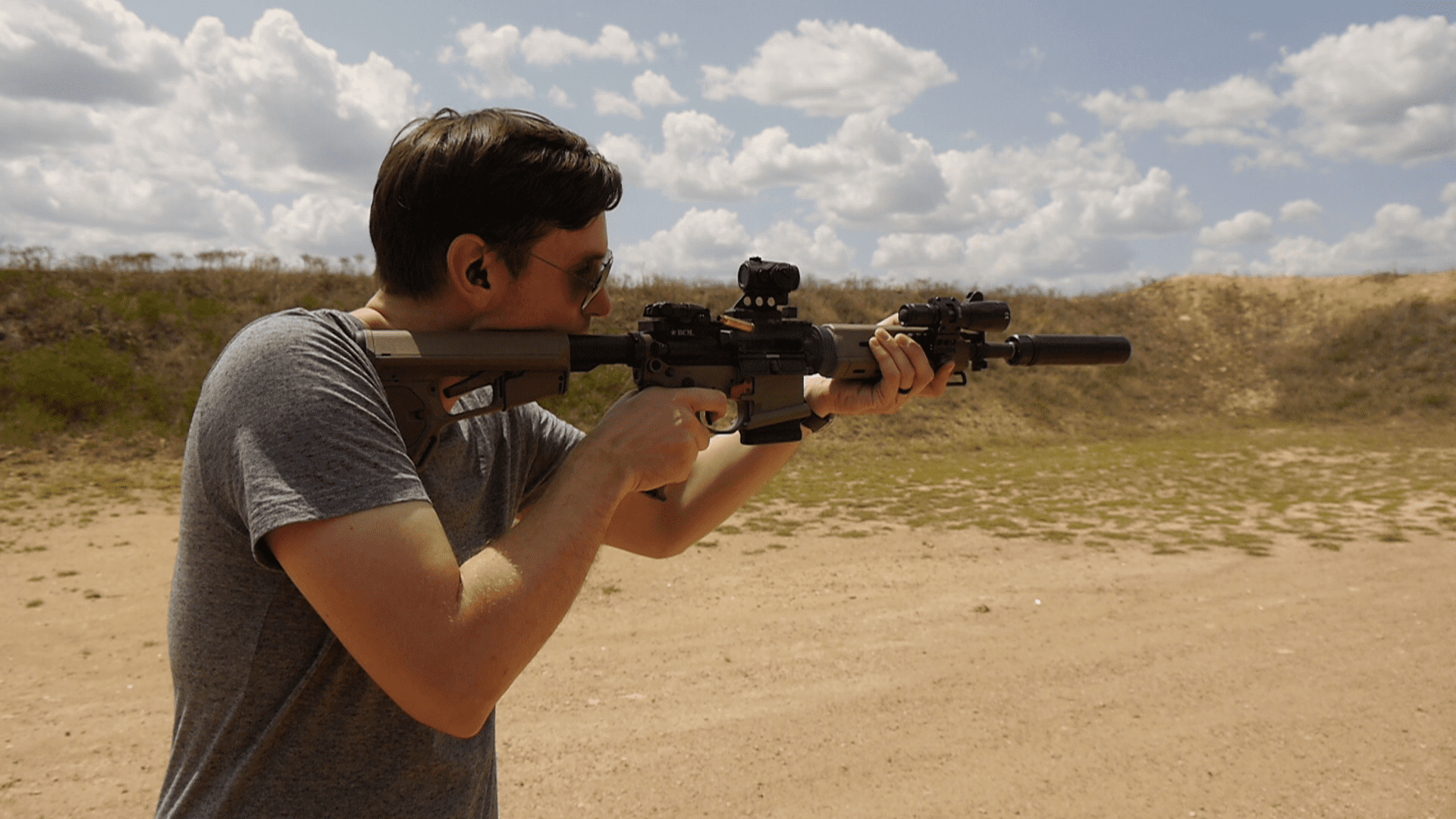Guns are loud, and short barreled AR-15s are the worst. When I’m taking newbies to the range for the first time that noise is usually what scares them the most. A word of caution: even if you have a silencer attached to your SBR’s AR in a home defense situation it’s going to sound like a mini flashbang going off in your house.
In the typical 5.56 NATO flavor, the common belief is that subsonic ammunition doesn’t really work. The relatively small 5.56 NATO round gets all its power from its velocity…a lightweight projectile at very high speed is just as deadly as a slower moving chunkier hunk of lead.
In order to slow down that projectile so that it doesn’t break the sound barrier (and create the sonic “crack” that makes even suppressed guns sound loud) you would need to increase the weight of the bullet, and getting the balance just right is extremely difficult. That’s one of the reasons why the 300 AAC Blackout round has become so popular: how easy it was to go from supersonic to quiet-as-a-churchmouse subsonic without changing the gun.
Allegiance Ammunition doesn’t seem to have listened to the conventional wisdom. They’ve started producing a couple different flavors of subsonic .223 Remington ammo (interchangeable with 5.56 NATO, a concept I’m sure will fill the comment section below with many opinionated responses on why I’m an idiot and completely wrong) with some interesting characteristics.
Allegiance’s SilentStrike line of ammo is designed as a drop-in subsonic replacement for your rifle’s standard diet of 5.56 NATO cartridges. No alterations are required to the firearm, all you need load the ammo in a magazine and you’re good to go.
Something that makes SiletStrike extra special is the projectile Allegiance uses. Instead of a standard solid lead projectile the bullet is made of compressed tungsten powder.
According to Allegiance this allows the round to penetrate soft tissue for self defense or hunting scenarios while still fragmenting on impact for harder targets like steel plates for training. That’s an intriguing mix, and while I didn’t have enough samples to take some hunting, I was able to confirm that the projectiles will harmlessly fragment on impact with a steel plate.
Out on the range we tested the ammo in a number of different conditions. Allegiance sent two flavors to test, a 110 grain compressed tungsten version and a more traditional jacketed 97 grain version. As you can probably tell from the video above, the 110 grain ammo functioned perfectly in my standard 10.5-inch AR-15. The trigger (which was a prototype in for testing) had some issues, but it had problems with standard ammunition as well, so I’m not going to count that against the SilentStrike.
When I was talking with Allegiance before the samples arrived we discussed how those three factors — bullet weight, velocity, and barrel length — play an important role in ensuring the reliable operation of the firearm. Especially when you’re on the extreme low end of the spectrum for velocity and barrel length, small differences can have a big impact.
Their 110 grain ammo worked perfectly in my test rig as pictured at the top of the article, but remove the silencer and reliability became spotty. That extra back pressure a suppressor provides is really important when there isn’t much gas volume produced by the cartridge.
Even with a longer barrel, reliability still isn’t assured, as you can see in this picture above. Adding a silencer seems to be the best way to improve reliability when shooting SilentStrike. I doubt anyone would spend the cash ($48 for a box of 20) on these specialty rounds without having a can in hand. It just doesn’t make sense.
Also important is stabilization of these extra long, extra slow projectiles. Allegiance says that a 1:7 twist rate barrel is most important for accuracy, putting a tighter spin on the bullet as it leaves the barrel than would a more common 1:9 barrel designed for high velocity projectiles.
From my 1:7 twist gun I was getting a solid 3 MoA spread downrange, which is remarkably good for (A) a short-barreled AR and (B) subsonic ammunition. That’s accurate enough to be “minute of bad guy” at any distance where subsonic ammo is going to make a difference.
The “killer app” here is that the ammunition actually works, despite the conventional wisdom. There are other companies who make subsonic 5.56 NATO ammunition, but every product description I can find includes the caveat, “does not cycle the action.” They try to sell this as a good thing, that it reduces noise, but if I wanted a super quiet shooting platform I’d have gotten a bolt action rifle and not a semi-auto. I want what I paid for, and Allegiance SilentStrike delivers.
Specifications: Allegiance Ammunition Silent Strike Subsonic Frangible .223 Remington
Bullet Weight: 110 grains
Bullet Composition: Compressed tungsten
Cartridge Caliber: .223 Remington (5.56 NATO compatible)
Cartridge Velocity: 975 fps
MSRP: $48 for 20 rounds
Ratings (out of five stars):
Accuracy * * *
I’m not expecting much from subsonic ammunition to start with and 3 MoA is about normal. I’d love to get some more of this ammo and run it through a chronograph, but we spent the majority of our allotment doing function testing.
Reliability * * *
It really does cycle the action…as long as you’re using the correct configuration. Silencers are a requirement to get the maximum reliability, but there are probably instances where it will work unsuppressed as well. The moral of the story here is to burn at least one box of ammo confirming that your gun works as configured with this ammo before trusting it. In mine, it works flawlessly.
Overall * * * *
This is one of the most expensive boxes of .223 Remington ammunition I have ever shot, but if you’re looking for a subsonic .223 Rem cartridge that actually cycles the action, this is the only game in town I would trust.












This might be worthwhile for somebody with an AR and a can for home defense use.
But, Daaaaaym! That’s expensive!
Do you consider it hearing safe, as-is?
What caliber can did you run? I use a 30 cal can whenever I shoot subs just to help prevent a baffle strike. Won’t help if stabilization is completely FUBAR but will with most.
That American Flag rail cover is great.
OK, 110gr, 975fps = 232ft ilbs?? Get a KelTec 22 Magnum
.223 / 5.56 subsonic just sucks. The photo of the 110 grain round looks like a short overall length. I wonder if they could add a few more grains and get it to function without a can. At $48 a box, it would be worth it to just run a 300 BLK upper.
I think my quiet without a can approach will be .22 CB / shorts / subsonic from a 20″ pump Henry. Not very tactical, but a lot of fun.
Subsonic 223/5.56 is retarded. Normal subsonic 5.56 is barely any advantage over Aguila 60gr SSS 22lr. This particular load, 110gr at 975 fps comes out to 232 foot pounds of energy. For the cost of a few boxes, you could buy a .300 blk upper. Let alone standard 147 gr 9mm ammo that is almost always subsonic and good for around 325 ft/lbs and nearly twice the bullet diameter without expansion required. And if one loads, 9mm can make this 5.56 load look even worse buy using heavier weight bullets at 1000fps out of a carbine. And naturally one couldn’t forget the classic 230gr 45 acp. If one wanted to shoot subs from an AR, they would be better served buying a 300 blk, or .22lr upper. This in addition to the ignorance that is sbr fired 5.56. Ballistics by the inch would be a good website for some folks to visit. There you will see how a 10.5 inch AR firing 5.56 puts out about as much energy as 9mm from a carbine.
That’s pretty much what I said about the other subsonic .223 rounds in an article last week, except that one was for barrels optimized for the round too. I just don’t get why these are a thing when several pistol calibers would vastly outperform these for much less money.
Kinda cool that they’re made out of tungsten, I’m surprised they aren’t classifying them as AP pistol rounds even though they’re sintered.
Suppressed AR9 with 147 gr hollowpoints at fifty cents a round = much better than spotty performance for two dollar rounds.
tungsten is extremely hard. I’d be worried about barrel wear using this stuff.
And a 110 gr .223 bullet? Just how long is it? How does that affect stability and more importantly for silencer use, yaw at the muzzle?
$48 for 20 rounds? Seriously? HAHAHHAHAHAHHAHAHAHHAHA
Hi Sir,
I would love to send you some of our 300 blackout subsonic to get your thoughts on it.
Tony Watson
http://www.defensearmssyndicate.com
We have produced a polymer alloy frangible projectile that is gaining interest with TOP OEMs. was wondering if you would like to test them as well. the price for ours is much much better and it is currently performing better than the MK311.